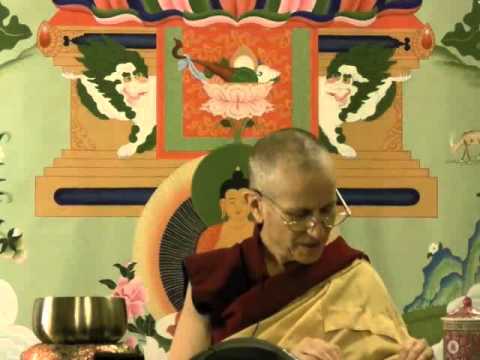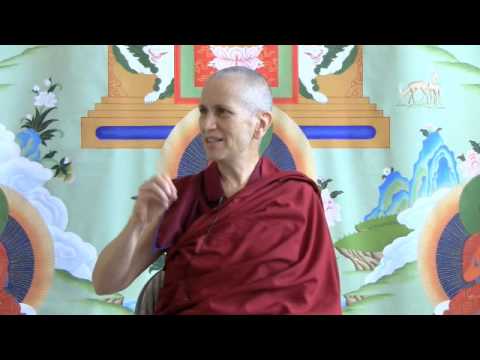Questioning our perceptions
Part of a series of Bodhisattva's Breakfast Corner talks given during the Green Tara Winter Retreat from December 2009 to March 2010.
- Studying the Dharma often results in us questioning our thoughts
- Emptiness, ethics, and valid perceptions
- Emptiness and dependent arising do not contradict each other
Green Tara Retreat 021: Questioning perceptions and what is valid (download)
Audience: When it comes to dealing with others, I find that after studying the emptiness teachings, I can spend a lot of time second-guessing myself. Even after checking my mind before acting, even after checking my motivation before acting, often I still come back after the act and second-guess myself. I guess I just feel that because I am ignorant I’m never 100 percent sure.
Venerable Thubten Chodron (VTC): When you study emptiness (even when you don’t study emptiness, when you study the Dharma in general) you begin to question your thoughts and ask yourself if what you’re perceiving is true, if what you’re thinking is true, if your assumptions are true, if what’s appearing to you is true.
Audience: As I understand it, we ordinary beings do not see things accurately.
VTC: Correct.
Audience: Things do not appear to ignorance as things would appear to wisdom. But we ignorant beings still have to make decisions. Things come up. We have to act. Could you speak a little on emptiness and ethics, on valid perceptions? How something can be a valid perception, like seeing a snake where there is a snake and acting appropriately, even though one is at the same time not seeing the snake accurately, as wisdom would.
VTC: So how can we have a valid perception and knowing that it is not accurate, still act with real confidence?
This has to do with how emptiness and dependent arising do not contradict each other. Things can be empty, but they still arise dependently. We still can have reliable conventional cognition of different objects, even though we’re not seeing the ultimate nature of those objects. So we have to backtrack a little bit here.
When we analyze to try to find the object in its basis of designation, I look at this thing [she’s now looking at a chair] and I try and find the chair in that collection of parts; or I try and find Jampel in that collection of parts. When we’re doing that, when we look and we can’t find anything that we can draw a line around and say, “This is actually what the object is. This is actually what the name is referring to,”—then we are searching in the basis of designation and not finding the object. But we are searching for an inherently existent object. We are not finding that in the basis of designation. That means that it’s empty of inherent existence.
At that time when you see that directly, after you’ve done it inferentially, when you have a direct perception then only emptiness appears to your mind—not the object appearing to your mind. That doesn’t mean that the object stops existing, and finding the emptiness of an object doesn’t mean that that object no longer exists. It just means that it doesn’t exist inherently. The object still exists.
Now when you come out of your meditation, then your perceptions are like ours are now: where things still appear truly existent. But they’re different from ours in the sense that the arya doesn’t grasp them to truly exist. Whereas when things come up with us, we grasp them as truly existent. Not all the time, but when we get triggered we certainly do. What we’re getting at is that seeing the emptiness of something does not negate its conventional existence. It doesn’t mean that the thing stops existing conventionally.
Mistaken vs. erroneous
Furthermore, our conventional consciousnesses that perceive these things may be mistaken with respect to the fact that inherent existence is still appearing to them. But not all of our conventional consciousnesses are erroneous, because not all of them grasp that appearance as true and grasp the objects as truly existent.
There are two points here. [First:] There’s the appearance of true existence–just due to the ignorance and the latencies, and things appear that way to us. [Second:] Then sometimes our mind grasps things. It’s as though, “Oh yes, they are truly existent.” We’re not saying that to ourselves, “Oh yes, this is truly existent.” But that’s the way our mind is holding the object as, “Yes, this thing is real. This chocolate cake is real. I want some! There’s a real me that wants it.” All those kinds of things.
When we’re grasping at true existence, that mind is erroneous because things are not truly existent as that mind is holding them to be. When we’re not grasping at true existence, things are appearing to the mind but we’re not holding them in that wrong way. So that consciousness is mistaken, but it’s not erroneous. Whereas the one that’s grasping at true existence is [both] mistaken because inherent existence is appearing to it and it is also erroneous because it’s holding that appearance as true.
In reference to what we call the appearing object, things can be mistaken. Our conventional consciousnesses are mistaken because things are appearing truly existent to them. The wisdom realizing emptiness is when you have a direct realization that is not mistaken, because emptiness exists the way it appears. Emptiness is empty and it appears empty.
From the viewpoint of what’s appearing to the consciousness, the realization of emptiness is non-mistaken. Our conventional consciousnesses are mistaken because inherent existence appears to them. In terms of the apprehended object (of what we’re actually holding on to in our conventional world), when we’re not grasping at true existence, we’re perceiving the cat as the cat, and the bottle as a bottle. That is a reliable conventional consciousness even though it’s mistaken in that the cat, and that bottle, and the chair, and so on are appearing truly existent to it.
When I have a lot of attachment for something, such as, “I want that fancy car,” then that’s truly existent. I’m truly existent. My attachment is coming out of that. That consciousness is not only mistaken because things are appearing as true existence, but that is also erroneous because I’m grasping at true existence.
For an arya who has direct realization of emptiness while in meditative equipoise on emptiness, things do not appear truly existent. They are not grasping at true existence. Their consciousnesses are neither mistaken, nor erroneous. When they come out of meditative equipoise, they have the appearance of true existence but they don’t believe it to be true. While they’re meditating on emptiness, there’s not the appearance and there’s not the grasping. That consciousness is not mistaken, and it’s not erroneous.
Audience: And it’s due to the self-grasping that the afflictions arise in relationship to the self-grasping?
VTC: Yes.
Audience: As long as self-grasping is up there, the afflictions are?
VTC: Right, it’s self-grasping that is making the afflictions arise. Remind me of this later because this is the whole reason why emptiness is important to realize. If we don’t understand this point—that the afflictions arise out of self-grasping—then we don’t understand why it’s important to realize emptiness.
I’ll answer the rest of the question tomorrow. I think you have enough to digest.
Venerable Thubten Chodron
Venerable Chodron emphasizes the practical application of Buddha’s teachings in our daily lives and is especially skilled at explaining them in ways easily understood and practiced by Westerners. She is well known for her warm, humorous, and lucid teachings. She was ordained as a Buddhist nun in 1977 by Kyabje Ling Rinpoche in Dharamsala, India, and in 1986 she received bhikshuni (full) ordination in Taiwan. Read her full bio.


